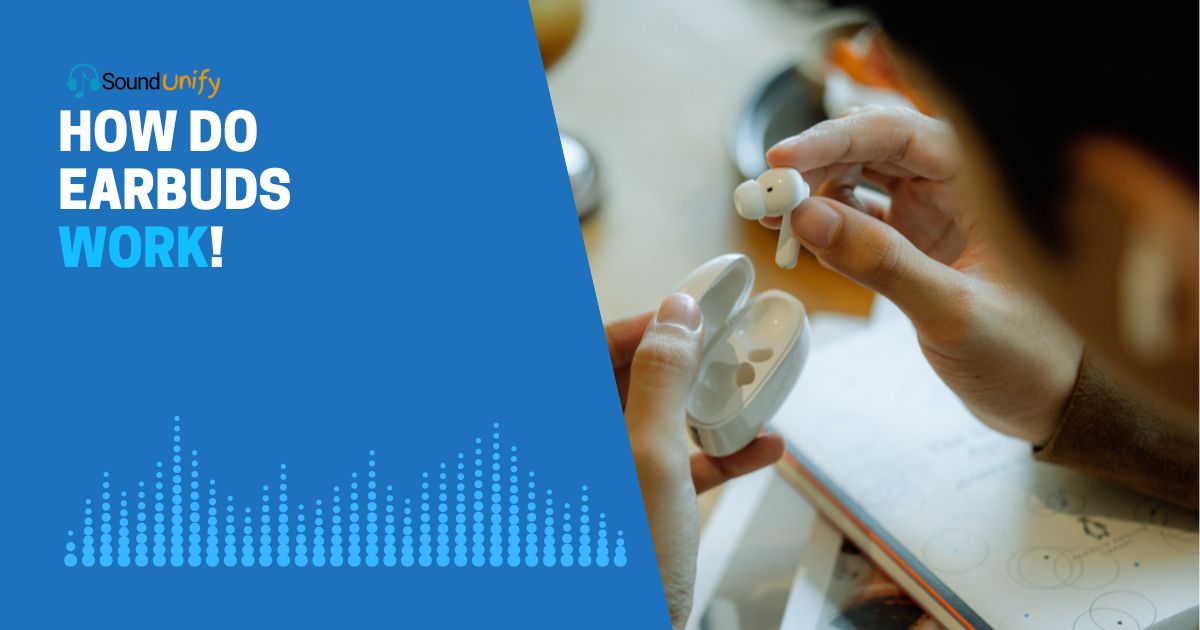Earbuds transform electrical signals into sound. It's science, but it feels like magic.
I still remember the first time I popped a pair of these tiny gadgets into my ears and felt transported to another world. But how? These pint-sized devices don’t just play our favorite tunes.
They’re a result of intricate engineering and fascinating physics. Behind that compact exterior lie layers of complex mechanisms working in harmony. Have you ever found yourself intrigued by the bass drop or the clarity of vocals through your earbuds? I have. And it sent me on a mission.
Dive in with me, and together, we’ll unravel the intricacies of these everyday marvels. Because once you understand ‘how do earbuds work,’ you’ll never listen to your music the same way again.
What Are Earbuds?
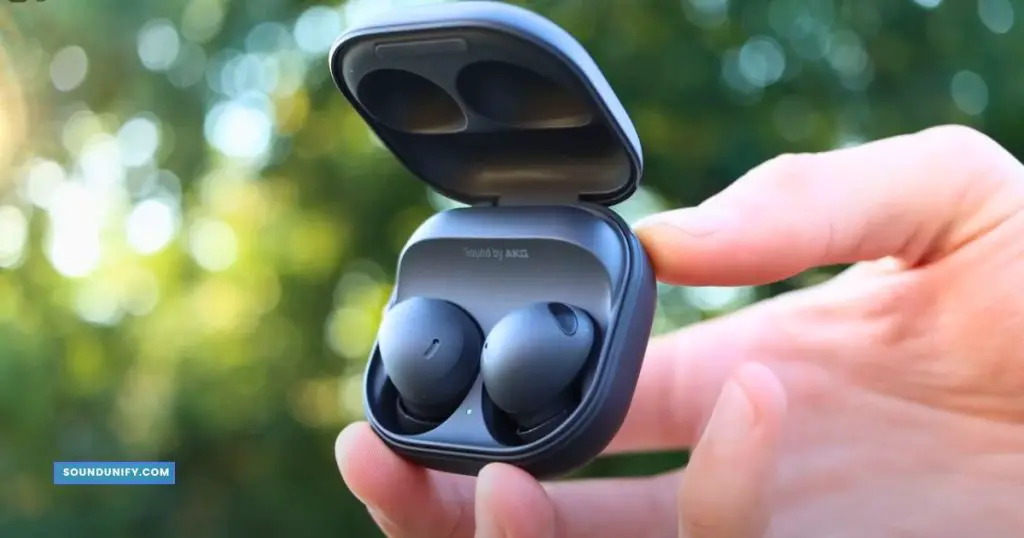
Earbuds are miniature speakers designed to fit snugly inside your ear canal. They have evolved from mere audio devices to multifunctional gadgets.
Earbuds are your go-to accessory for listening to music or podcasts, hands-free communication, and fitness tracking. Unlike their over-ear or on-ear cousins, they offer compactness and portability.
In 2023 alone, over 300 million wireless earbuds were sold globally—testimony to their growing ubiquity.
| Types of Earbuds | Pros | Cons |
|---|---|---|
| Wired Earbuds | Affordable, Simple, Universal Compatibility | Limited Range, Wear, and Tear |
| Wireless Earbuds | Freedom, Advanced Features, Stylish | Battery Life, Cost |
| True Wireless Earbuds | No Wires at All, High Functionality, Compact and Portable | Limited Battery, Easy to Lose |
| Noise-Canceling Earbuds | Sound Quality, Focused Listening, Health Benefits | Price, Battery Drain |
| Sport Earbuds | Water-Resistant, Secure Fit, Fitness Tracking | Limited usage May have inferior Sound Quality |
Exploring How Earbuds Work
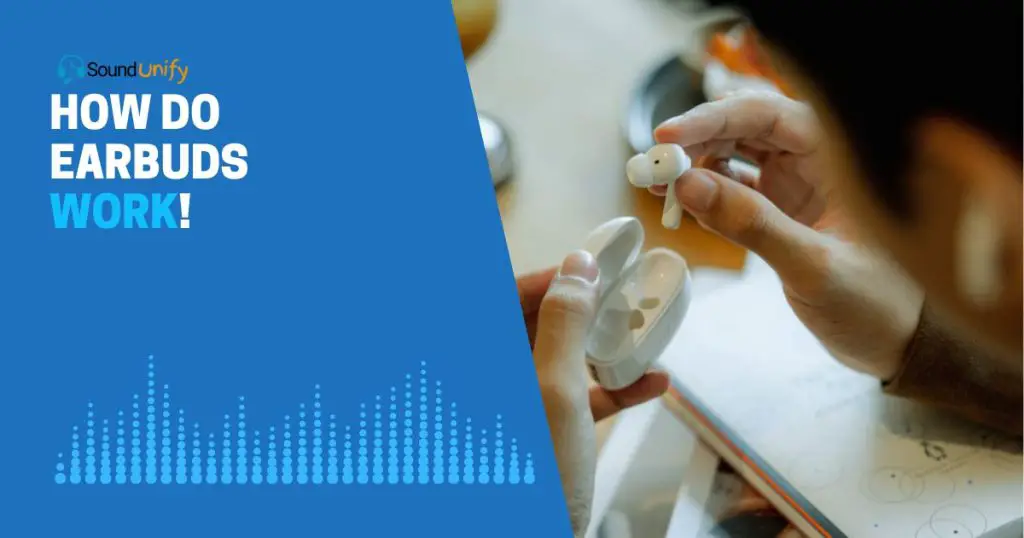
Earbuds, those compact devices that provide a world of sound, come in two primary types: wired and wireless. Each operates using distinct principles and components, though both aim to deliver clear, immersive audio directly to your ears.
Let’s explore the fascinating workings of both.
How Do Wired Earbuds Work?
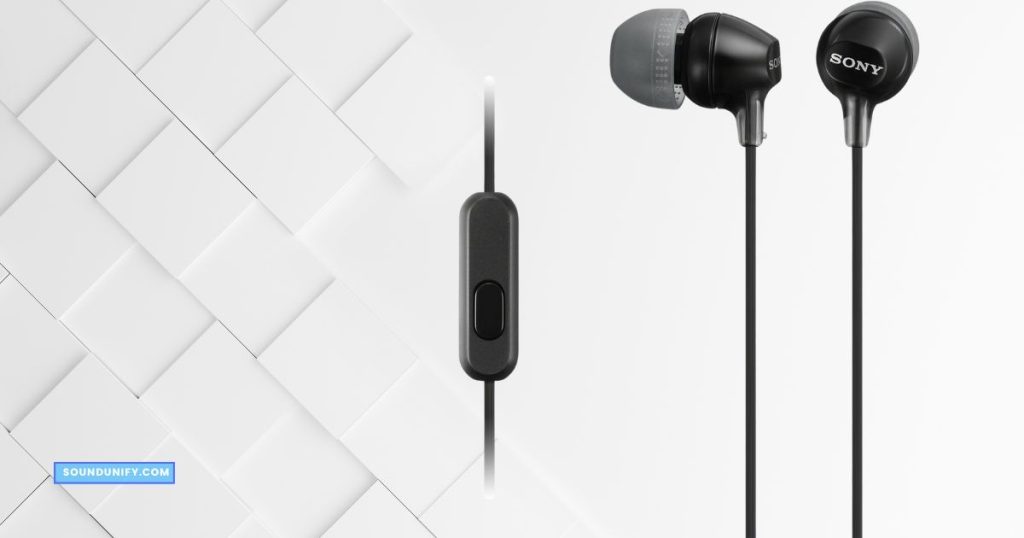
Wired earbuds! They’ve been my go-to for years, and I’ve always been intrigued by their workings. At first glance, they might seem simple, just plug-and-play, right? But once I delved deeper, I realized they’re tiny masterpieces of technology. Let’s unwrap this mystery together!
1. The Journey Begins with a ‘Play’:
Every auditory adventure with wired earbuds starts with a simple action: pressing the ‘play’ button on your device. Think of this moment as setting a boat on a flowing river. When you tap ‘play,’ your favorite song, podcast, or voice note is transformed from a digital file into an electrical signal.
This signal carries a complex blend of vocals, instruments, beats, and pauses. It’s an intricate dance of positive and negative charges, moving at incredible speeds. This electrical river then flows down the earbud’s wire, eager to reach its final destination: the tiny speakers nestled within each earbud.
When you press ‘play,’ you’re not just starting a song. You’re igniting an electrical ballet that happens in milliseconds but delivers hours of enjoyment.
2. The Magical Connector
The unsung hero of this musical journey is the earbud’s connector, commonly referred to as the jack. This tiny piece of metal is crucial in transmitting your song’s electrical signal from your device to your earbuds.
- Function: The jack establishes a secure connection between your device and the earbuds. It ensures the electrical signal flows smoothly and without interruption.
- Materials: Typically made from metal, often gold or silver plated, which ensures minimal signal loss and maximum fidelity.
Here are the types of jacks you might come across:
| Jack Type | Description | Common Use |
|---|---|---|
| 3.5mm | The everyday hero of Jack. | Most smartphones, laptops, and audio devices. |
| 1/4-inch | Larger and sturdier. | Professional audio equipment and musical instruments. |
| 2.5mm | A less common, slightly slimmer variant | Some older mobile phones and communication devices. |
Despite its small stature, the jack has undergone numerous evolutions to cater to the changing demands of audio technology. And while the world seems to be moving towards a wireless future, the charm and reliability of a wired connection, starting with this magical connector, still hold a special place in many hearts.
3. Meeting the Heartbeat – The Driver
The driver in earbuds feels like the heart in our bodies. It’s where the magic comes alive. Every time that electrical signal reaches the earbud after traveling down the wire, it meets the driver.
Now, the driver isn’t just one piece. It’s a complex structure of several components, each with a specific role in turning that electrical signal into beautiful sound.
- Magnet: Often made from neodymium, this component creates a magnetic field.
- Voice Coil: A coil of wire that sits within the magnetic field. When the electrical signal reaches this coil, it starts to move.
- Diaphragm: This is attached to the voice coil. As the coil moves, the diaphragm also pushes and pulls air rapidly.
Here’s a table detailing the components and their functions:
| Component | Function |
|---|---|
| Magnet | Creates a consistent magnetic field. |
| Voice Coil | Moves within the magnet’s field when the electrical signal arrives. |
| Diaphragm | Vibrates with the coil’s movement, generating sound waves. |
This entire setup operates on electromagnetism. The dance between the voice coil and the magnet, powered by the song’s electrical signals, causes the diaphragm to vibrate. And that vibration? It’s what makes the sound.
4. Sound Waves & You
Sound waves are fascinating. They’re invisible ripples in the air, yet they have the power to evoke deep emotions. When the diaphragm in the earbuds vibrates, it sends these ripples – or sound waves – into your ear canal.
As they move, they cause the delicate structures within your ear, especially the eardrum, to vibrate. The brain interprets these vibrations, and that’s how we perceive sound.
It’s a journey of energy, from electrical signals to mechanical vibrations to neural signals in the brain. This transformation is a testament to the intricacies of technology and human anatomy, working in harmony to create the sensation of hearing.
5. Controls At Your Fingertips
Isn’t it incredible how we can manage our auditory experience without touching our devices? That’s the magic of the control module on wired earbuds. Often found along the wire, this module is a mini command center.
- Play/Pause Button: The most common button, letting you start or halt your music whenever you wish.
- Volume Up/Down: Gives you the freedom to immerse yourself in the music or remain aware of your surroundings.
- Call Functions: Some modules even allow you to take calls, making the switch from music to conversation seamless.
| Control | Function |
|---|---|
| Play/Pause | Starts or stops the track. |
| Volume Up/Down | Adjusts the track’s loudness, offering customization for every environment and mood. |
| Call Button | Answer or end calls, ensuring you stay connected without diving into your pocket or bag. |
The next time you adjust the volume or skip a track using these controls appreciate the convenience. They transform the simple act of listening into a smooth, intuitive experience, keeping the power at your fingertips.
How Do Wireless Earbuds Work?
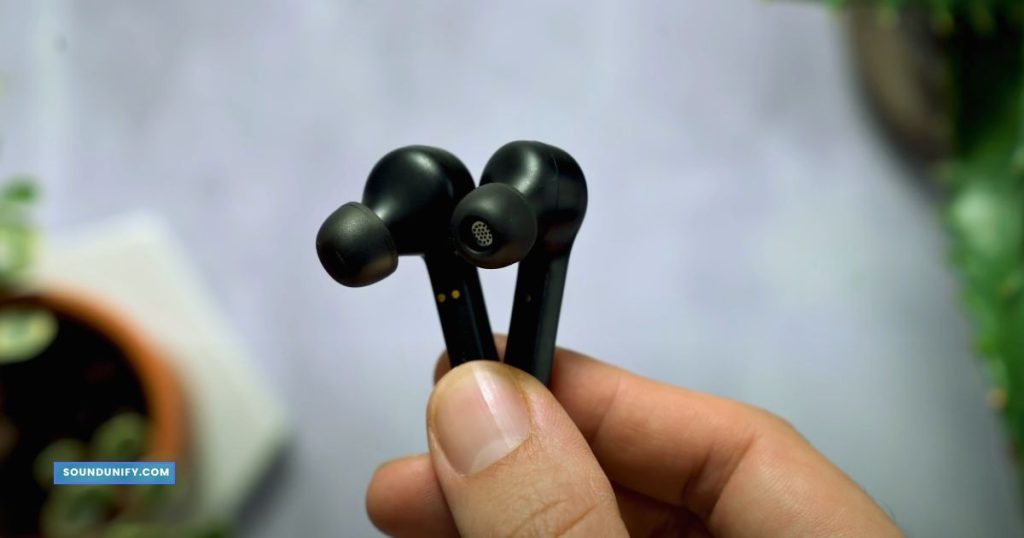
Wireless earbuds have revolutionized personal audio. Operating without the constraints of a physical connection, these devices utilize a blend of digital protocols, microelectronics, and software algorithms. Let’s delve into the technicalities.
1. Digital Transmission: Bluetooth and Beyond
In the vast realm of wireless audio, Bluetooth stands tall as the foundational pillar for wireless earbuds. At its core, Bluetooth is a protocol that establishes a secure and efficient wireless connection between devices. However, what’s fascinating is the technical depth beneath its smooth operation.
- Frequency Band: The primary frequency that Bluetooth devices use is the 2.4 GHz ISM band. This band, although crowded, offers a global, unlicensed spectrum for short-range transmission.
- Data Transmission and Modulation:
- Spread Spectrum: This technology disperses the signal over a wide frequency range, minimizing interference.
- Frequency Hopping: Devices change frequencies rapidly (often up to 1600 hops/sec), ensuring secure connections and reducing the risk of eavesdropping.
- Protocols and Profiles: While Bluetooth is the underlying tech, the various profiles give it versatility.
- A2DP (Advanced Audio Distribution Profile): This profile is why we can stream high-quality audio wirelessly.
- AVRCP (Audio/Video Remote Control Profile): Lets you control playback functionalities like Pause, play, and volume.
| Feature | Technical Detail |
|---|---|
| Frequency | 2.4 GHz ISM Band |
| Modulation | Spread-Spectrum, Frequency Hopping |
| Audio Streaming Profile | A2DP |
| Control Profile | AVRCP |
Beyond Bluetooth: While Bluetooth remains predominant, researchers and developers are exploring other protocols and technologies for future enhancements, like Wi-Fi Direct, NFC, and Light Fidelity (Li-Fi).
2. Integrated Circuits and Chipsets
Peek inside those tiny earbuds, and you’re met with the marvel of miniaturization – the integrated circuits and chipsets. These are the brains and the brawn of wireless earbuds, ensuring everything runs seamlessly.
- System on Chip (SoC): This is the magic bean of modern tech. An SoC in wireless earbuds integrates several functions into one tiny chip, streamlining operations and conserving power.
- Digital Signal Processor (DSP): Manages digital signal conversion, responsible for the clarity and quality of sound you hear. Many DSPs come embedded with algorithms for noise cancellation, bass enhancement, and equalization.
- RF Transceivers:
- Role: This component manages the reception and transmission of wireless Bluetooth signals, ensuring a stable connection with the source device.
- Antennas: A crucial part of the RF system, they catch and send signals, often designed innovatively to fit within the earbud’s compact form.
- ADC/DAC Converters:
- ADC (Analog to Digital Converter): Converts the analog sound signals into digital for processing.
- DAC (Digital to Analog Converter): Once the signal is processed, it converts it back to analog to produce sound.
| Component | Function |
|---|---|
| SoC | Integrates multiple functions into one chip. |
| DSP | Manages digital signals and enhances sound quality. |
| RF Transceiver | Sends and receives Bluetooth signals. |
| ADC/DAC | Converts signals between analog and digital. |
3. TWS: True Wireless Stereo Technology
The rise of TWS (True Wireless Stereo) technology has changed how we perceive wireless audio. Before TWS, while we had wireless earphones, they often had a neckband or a wire connecting the two earpieces. With TWS, even that slim wire is gone, giving us true freedom.
- Enslaver and Slave Configuration: In a TWS setup, one earbud acts as the master, receiving the audio signal from the device first. This master earbud then communicates and forwards the signal to the second earbud, the slave. Such a setup ensures minimal latency between the audio playback of the two earbuds, ensuring synchronized playback.
- Near-Field Magnetic Induction (NFMI): Some TWS earbuds use NFMI for inter-earbud communication, offering a more stable connection with lower latency than Bluetooth. NFMI creates a small magnetic field around the ear. The master earbud sends audio signals through this field, which the slave earbud picks up.
- Secondary Bluetooth Link: Some TWS systems prefer using a secondary Bluetooth connection for master-slave communication. While a more universal standard, it can sometimes introduce slightly more latency than NFMI.
4. Sound Production: Electroacoustic Transduction
At the heart of any audio device lies its ability to convert electrical signals into sound, a phenomenon known as electroacoustic transduction. It’s where the digital becomes audible.
- Dynamic Drivers:
- Most Common Type: These are the most widespread drivers in earbuds.
- Function: They operate like tiny speakers, where a diaphragm/cone attached to a coil moves within the magnetic field, producing sound.
- Balanced Armature Drivers:
- Specialized Usage: Often found in professional and high-end earbuds.
- Function: They use an armature (a tiny lever) that vibrates within a coil of wire. As current flows through this coil, it changes magnetic fields, causing the armature to move and produce sound.
- Planar Magnetic and Electrostatic Drivers:
- High-End Segment: These are less common and are typically reserved for premium earbuds and headphones.
- Function: They use a combination of electrically charged diaphragms and magnetic fields to produce sound, resulting in very detailed and accurate audio reproduction.
5. Power Management and Battery Life
Power management in wireless earbuds is a masterclass in efficiency. Nestled within most earbuds are Lithium-Ion (Li-Ion) or Lithium Polymer (Li-Po) batteries, lauded for their compactness yet impressive energy density. They’re lightweights that pack a punch.
However, it’s not just about the battery; it’s about reasonable usage. Earbuds are optimized to use power differently during active playback versus standby. Their ability to ration battery life based on need ensures longevity.
Every time you enjoy hours of music without reaching for a charger, remember the silent marvel of power management at work. This intricate balance of hardware choice and smart energy distribution.
How to Choose the Right Earbuds for You?
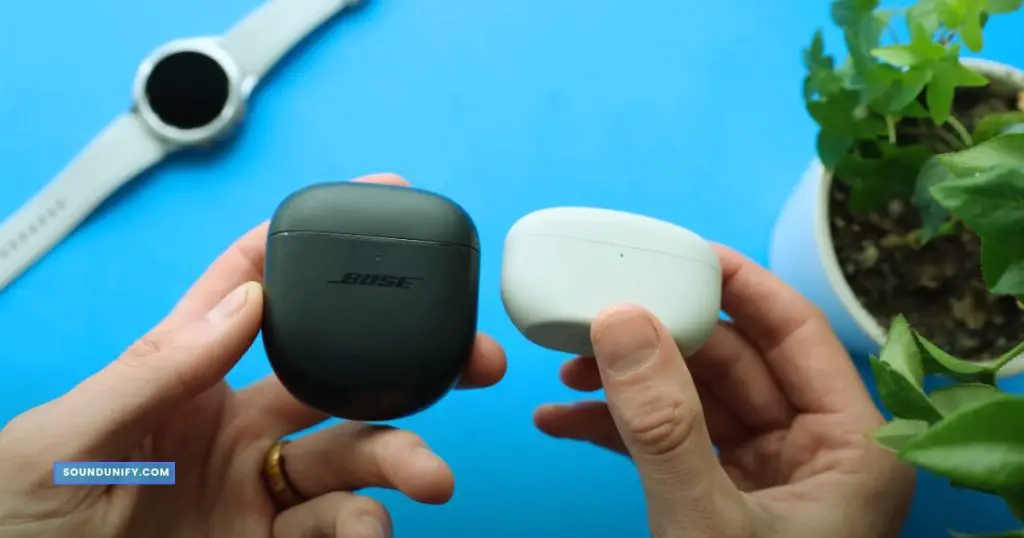
Are you embarking on the quest for the perfect earbuds? It’s a blend of science and personal preference. Here’s a roadmap to help you navigate the options and make an informed choice.
1. Wired vs. Wireless
- Wired Earbuds: These come with a cable that plugs directly into your device. They don’t need batteries, offer consistent sound quality, and there’s no latency. However, they can get tangled and might be inconvenient if your device lacks a headphone jack.
- Wireless Earbuds: Bid farewell to tangled cords! Perfect for those on the move. They connect via Bluetooth, but they need charging. Sound quality has improved massively but can vary based on the Bluetooth codec.
2. Fit and Comfort
- Ear Tip Size: Most earbuds have multiple silicone or foam ear tips. Finding the right size ensures a snug fit, better noise isolation, and improved sound quality.
- Design: Some prefer the traditional in-ear design, while others prefer earbuds with wingtips or neckbands. Your choice might also hinge on activities like working out, where stability is key.
3. Sound Quality Preferences
- Bass, Mids, and Treble: Are you a bass lover or crave crystal-clear vocals? Understanding your preferences will guide you to earbuds that emphasize those frequencies.
- Drivers: Larger drivers or multi-driver systems can offer richer sound, but the tuning and quality of the drivers are also crucial.
4. Noise Isolation vs. Noise Cancelling
- Noise Isolation: Achieved through a good earbud fit, it physically blocks external noise.
- Noise Cancelling: This tech, often seen in pricier models, uses microphones to detect and neutralize external noise. It is excellent for commuting or noisy environments but can be battery-draining.
5. Extra Features
- Water Resistance: Planning workouts or rainy commutes? Check for IP ratings. IPX4 or higher offers good water resistance.
- Touch Controls: Some earbuds allow track changes, volume control, or assistant access with simple taps or swipes.
- Battery Life: If opting for wireless, check the battery lifespan. Some offer quick charging, providing hours of playtime in mere minutes.
6. Price Point
Your budget plays a pivotal role. While higher-end earbuds often offer more features and better sound quality, numerous budget-friendly options deliver exceptional value. Remember, the most expensive isn’t always the best for your needs.
Lastly, always consider reading reviews, trying out if possible, and understanding the return policy. After all, earbuds are a personal choice, and what fits me might not fit you. Happy listening!
FAQs
Q: How do I use earbuds?
A: To use earbuds, you must ensure they are charged and in pairing mode. Then, you can pair them with a Bluetooth-enabled device by entering its Bluetooth settings and selecting the earbuds from the list of available devices. Once paired, you can start playing audio through the earbuds.
Q: How do earbuds without a wire work?
A: Earbuds without a wire, also known as true wireless earbuds, work using Bluetooth technology to connect each earbud wirelessly to a device. This eliminates the need for any physical wire between the earbuds.
Q: Do wired headphones sound better than wireless earbuds?
A: The sound quality of wired headphones and wireless earbuds can vary depending on the specific models. While some wired headphones may offer a higher quality audio experience, many wireless earbuds today use advanced technology to provide excellent sound quality.
Q: How do earbuds send audio data wirelessly?
A: Earbuds send audio data wirelessly using Bluetooth technology. When paired with a device, they receive the audio data from the device and convert it into sound waves that can be heard through the earbuds.
Final Thoughts
Delving into the intricacies of earbuds has been enlightening! From intricate wired mechanics to advanced wireless tech, how sound journeys into our ears is a marvel.
Appreciating the magic behind tiny earpieces, I realize the complexity of seemingly simple devices. Every beat, note, and harmony?
There’s science, engineering, and passion behind it. Indeed, understanding earbuds elevates my listening experience. What a journey!
James Dimento is a Chief-in-Editor of SoundUnify. He is a headphone enthusiast and creative writer passionate about audio technology. He has three years of experience writing about headphones and sound quality and is responsible for creating reviews and taking care of all administration.
